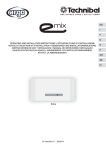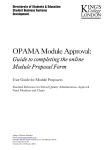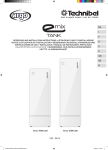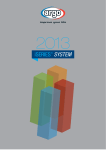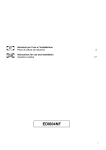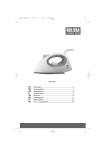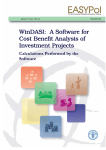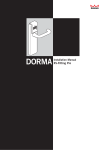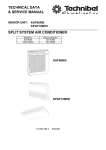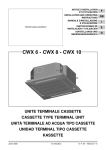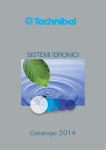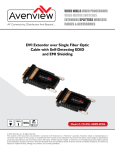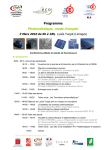Download EMIX EMIX TANK 220 EMIX TANK 300 EMIX
Transcript
OPERATING INSTRUCTIONS • ISTRUZIONI D’USO INSTALLATION INSTRUCTIONS • ISTRUZIONI D’INSTALLAZIONE Emix EMIX EmixTANK TANK220 220 EMIX 37.4163.351.00 Emix TANK300 300 EMIX TANK 05/2013 EG I Contents Generalities Introduction Rating data How to install Emix Electrical connections Control panel How to use Emix How to use and set the electrical heater elements How to disconnect and/or remove Emix unit How to connect Emix to a solar thermal system EG 2 5 8 8 10 11 11 12 13 13 DECLARATION OF CONFORMITY This product is marked as it satisfies Directives: – Low voltage no. 2006/95/CE. – Electromagnetic Compatibility no. 89/336 EEC, 92/31 EEC and 93/68 EEC. This declaration will become void in case of misusage and/or from non observance though partial of Manufacturer’s installation and/or operating instructions. INFORMATION FOR CORRECT DISPOSAL OF THE PRODUCT IN ACCORDANCE WITH THE EUROPEAN DIRECTIVE 2002/96/EC At the end of its working life this equipment must not be disposed of as an household waste. It must be taken to special local community waste collection centres or to a dealer providing this service. Disposing of an electrical and electronic equipment and its batteries separately avoids possible negative effects on the environment and human health deriving from an inappropriate disposal and enables its components to be recovered and recycled to obtain significant savings in energy and resources. In order to underline the duty to dispose of this equipment and batteries separately, the product is marked with a crossed-out dustbin. F-GAS Regulation (EC) No. 842/2006 Do not vent R410A into atmosphere: R410A is a fluorinated greenhouse gas, covered by Kyoto Protocol, with a Global Warming Potential (GWP) = 1975. Generalities Recommendations • The personnel responsible for receiving the unit must conduct a visual inspection in order to identify all damage to which the unit may have been subjected during transport: refrigerating circuit, electrical cabinet, chassis and cabinet. • During installation, troubleshooting and maintenance operations, never use the pipes as a step: under the stress, the pipes may break and the refrigerant may cause serious burns. 2 IMPORTANT! Please read before installation This system meets strict safety and operating standards. For the installer or service person, it is important to install or service the system so that it operates safely and efficiently. For safe installation and trouble-free operation, you must: • Carefully read this instruction booklet before beginning. • Follow each installation or repair step exactly as shown. • Observe all local, state and national electrical codes. • Pay close attention to all warning and caution notices given in this manual. •The unit must be supplied with a dedicated electrical line. WARNING This symbol refers to a hazard or unsafe practice which can result in severe personal injury or death. CAUTION This symbol refers to a hazard or unsafe practice which can result in personal injury or product or property damage. In case of improper installation The manufacturer shall in no way be responsible for improper installation or maintenance service, including failure to follow the instructions in this document. SPECIAL PRECAUTIONS • During installation, connect before the refrigerant system and then the wiring one; proceed in the reverse order when removing the units. WARNING When wiring ELECTRICAL SHOCK CAN CAUSE SEVERE PERSONAL INJURY OR DEATH. ONLY A QUALIFIED, EXPERIENCED ELECTRICIANS SHOULD ATTEMPT TO WIRE THIS SYSTEM. • Do not supply power to the unit until all wiring and tubing are completed or reconnected and checked, to ensure the grounding. • Highly dangerous electrical voltages are used in this system. Carefully refer to the wiring diagram and these instructions when wiring. Improper connections and inadequate grounding can cause accidental injury and death. • Ground the unit following local electrical codes. • The Yellow/Green wire cannot be used for any connection different from the ground connection. • Connect all wiring tightly. Loose wiring may cause overheating at connection points and a possible fire hazard. • Do not use multi- core cable when wiring the power supply and control lines. Use separate cables for each type of line. When connecting refrigerant tubing • Keep all tubing runs as short as possible, accordingly to the allowable distances from the outdoor unit (see manual). • Use the flare method for connecting tubing. • Apply refrigerant lubricant to the matching surfaces of the flare and union tubes before connecting them; screw by hand and then tighten the nut with a torque wrench for a leak-free connection. • Check carefully for leaks before starting the test run. When servicing • Turn the power OFF at the main power board before opening the unit to check or repair electrical parts and wiring. • Clean up the site after the work, remembering to check that no metal scraps or bits of wiring have been left inside the unit being serviced. • Ventilate the room during the installation or testing the refrigeration system; make sure that, after the installation, no gas leaks are present, because this could produce toxic gas and dangerous if in contact with flames or heat-sources. 3 EG Installation location ● We recommend this appliance to be installed properly by qualified installation technicians in accordance with the installation instructions provided with the unit. WARNING EG ● ● ● Do not install this appliance where there are fumes or flammable gases, or in an extremely humid space such as a green house. Do not install the unit where excessively high heat-generating appliances are placed. Do not install the unit where the atmosphere is extremely damp or humid (e.g. greenhouse or laundry) it could be wetted by drops of water (i.e. in laundries). Electrical requirements ● ● ● ● Before installation, check that the voltage of the electric supply in your home or office is the same as the voltage shown on the nameplate. All wiring must conform to the local electrical codes. Consult your dealer or a qualified electrician for details. Each unit must be properly grounded with a ground (or earth) wire or through the supply wiring. Wiring must be done by a qualified electrician. CAUTION ● If the unit hasn’t been used for a long period, to warm up the system, the power mains must be turned on at least 1 hour before operation. Safety instructions ● ● Read this booklet carefully before using this appliance. If you still have any difficulties or problems, consult your dealer for help. This appliance is designed to give you domestic hot water. Use this only for its intended purpose as described in this Instruction Manual. WARNING ● Never use or store gasoline or other flammable vapour or liquid near the unit. It is very dangerous. CAUTION ● ● ● Never touch the units with wet hands. Do not let children play with the appliance. This appliance is not intended for use by persons (including children) with reduced physical, sensory or mental capabilities, or lack of experience and knowledge, unless they have been given supervision or instruction concerning use of the air conditioner by a person responsible for their safety. 4 Introduction Emix is the innovative indoor unit in the iSeries system range, able to provide domestic hot water from a thermodynamic source all year round, i.e. independently of the system’s operating mode. Emix and Emix tank are two components of the iSeries system which are added to the very broad range of indoor units. The purpose of Emix and Emix tank is to produce domestic hot water through storage, using the energy produced directly from the heat pump (therefore renewable energy) and providing the service at the same time as heating and EG cooling the environments, thanks to the various air and/or hydronic indoor units of the iSeries range. Emix and Emix tank differ by type of installation which they are allocated, but not by type of service or performance; they both make hot water up to thermodynamic 80°C when the heat pump is in both heating and cooling mode, without priority cycles or temporary interruption of the cooling service. Application examples and operation description It connects to any electric bolier It connects to any tank suitable for domestic hot water H2O H2O H2O H2 O It connects to any natural circulation solar tank suitable for domestic hot water It connects to any forced circulation solar tank suitable for domestic hot water dashed: components supplied by third parties 5 Emix and Emix tank must be connected to an outdoor unit of the iSeries range equipped with special software and a specific connection dedicated to Emix. The compatible outdoor units are all the following outdoor units of the iSeries range with EMX port (*) ARGO OUTDOOR UNITS TECHNIBEL OUTDOOR UNITS AEI1G30EMX GR9FI30R5IBA AEI1G42EMX GR9FI42R5IBA AEI1G50EMX GR9FI50R5IBA AEI1G65EMX GR9FI65R5IBA AEI1G80EMX GR9FI80R5IBA AEI1G110EMX GR9FI110R5IBA EG (*) All the previous models does not support Emix that is normally connected to EMX port, excluding AEI1G30EMX/ GR9FI30R5IBA that have only one port for single split configuration made to produce DHW by inverter outdoor unit. The following diagram illustrates the concept exposed on the previous page and shows a system configuration where three indoor direct expansion units, a hydrokit for a floor system and an Emix tank coexist, all connected to a G110EMX. AW 4 3 2 1 AW AF HK H 2O Emix always works in heating mode even if the other units are working in cooling mode; when these work in this mode, Emix is able to recover the heat which would otherwise be lost in the outdoor air, significantly increasing the energy efficiency of the entire system. There are several possible configurations with Emix and the one represented in the previous figure is just one of many. 6 In general we may summarise them with the following concept: Emix is a component that may be connected to the other types of indoor units of the iSeries range at the same time and without specific limitations by using the special connection for Emix and duly considering the length of the Emix pipe to be added to the total length set by the outdoor unit (we advise a specific insulation of the Emix pipes to guarantee the minimum dispersion of energy). Emix may also be connected to a standard refrigerant connection and normally dedicated to the indoor units; in this case it is not possible to perform the heating service of the domestic water when the system works in cooling mode. For this reason, the above mentioned configuration is advised only in the cases where Emix is used only as mono-split heat pump dedicated to domestic water (typical case of combination with the G30EMX outdoor unit) or with other EG Emixes to form a cluster application for the production of large quantities of domestic hot water from a renewable source (ex.: up to 4 Emixes for a total of 1200 l). If Emix is connected to a standard refrigerant connection and not to EMX port, remove jumper JP1 from PCB. Emix is compatible with any heat solar system. This huge flexibility is unique and lets you apply this technology also to the natural circulation solar systems that are very popular in Mediterranean countries. Instead Emix tank is a turnkey solution fitted with a tank that contains a special AISI316L stainless steel exchanger inside for solar systems. Emix is able to manage any third party tank, including electric boilers; this unique feature makes Emix an excellent solution not just for new systems but also to protect existing investments. It is recommended not to install the unit too far away from the tank. The maximum limit for hydraulic tube is 10 m. In case the new or existing tank is equipped with one or more electrical elements (up to 3), Emix uses them as a source of backup energy to the heat pump if this is temporarily deactivated or if the outdoor temperature is so low to require extra energy; a part of these functions can be activated during installation and can be de-activated by the end user with a special command on the Emix function button, others are automatically managed by the electronics and let the system work correctly (especially used for legionella-cycle). Emix tank is already equipped with three 1 kW electrical elements, also managed by the electronics and that can be enabled or disabled by the end user. Emix and Emix tank must always be connected to the electrical power supply in a separate manner compared to the connection of the outdoor unit of the iSeries system, which they are connected to with only the shielded cable of the two-wire communication bus as with all the other indoor units. Emix and Emix tank do not have any functional relation with the heating of the environment through internal air units or hydrokits and related hydraulic system on the hydronic side; Emix and Emix tank have the sole function of producing domestic hot water in every operating and applicative condition, with water reaching 80°C completely from a renewable source, i.e. without the aid of electrical elements; it is clear that if a solar system is connected to Emix, this will facilitate the work of Emix and the heat pump even further by taking the system’s energy efficiency to its maximum. Emix and Emix tank are built inside a white metal cabinet that is easy to integrate in any home or office and looks good next to other white goods such as fridges, electrical boilers, etc... The two devices are provided as standard with any component necessary for their regular operation and only require some external hydraulic components. These components are usually selected and provided by the installer when installing a boiler or a solar system (e.g. a mixing unit or a vent valve for excess pressure...) Emix and Emix tank have been designed to work with water pressures up to 10 bars and thus are compatible with water networks in every European country. They comply with the strictest European standards for the double insulation between the circulation of domestic water and the refrigerant. Emix and Emix tank are fully automatic and the end user must only decide the maximum temperature of the domestic water. This can be done by using the special Emix function key. A series of coloured LEDs will indicate the temperature of the water and some special operating conditions, for example the anti- legionella cycle, the active electrical elements, the deactivated heat pump etc... Therefore Emix and Emix tank must not be set with complicated menus for operating cycles or environment heating priority. These two very complex units are simple to use. 7 Rating data Power supply 220-240 V – 50 Hz Minimum power input 4 watt Max power input without connected electrical elements 70 watt Max power input with connected electrical elements 3x1500 watt Water connection 3/4” G – 3/4” G Refrigerant connection (R410A) 3/8” – 3/8” Net weight 16,5 Kg Dimensions (H/W/D) 272x527x285 A 3/4” water filter is supplied with Emix to be installed upstream of tap water connection. It is warmly suggested to install a softener or a polyphosphate filter to avoid limestone and consequently loses of performance; in addition to this service valves, mixing valve and overpressure valve are suggested. How to install Emix Emix works only with an iSeries outdoor unit system; it is commonly connected to the proper EMX port but could be connected also to a normal port like AEI1G30EMX/GR9FI30R5IBA that has an adapter from 3/8” to 1/4” for the liquid return flare. m 0,510 mm 0,80 mm 0.80 0.20 0.20 m A x B 4xØ9 Z EG Y 8 View of the bottom plate of the Emix 91 2 3 5 4 77 102 117 61 6 1 278 365 1. 2. 3. 4. 5. 6. refrigerant connection from outdoor unit to Emix flare 3/8” refrigerant connection from Emix to outdoor unit flare 3/8” cold water connection tap 3/4” hot water connection tap 3/4” conduit for electrical connections conduit for electrical connections Pay attention to respect the flow of refrigerant and of the water as above indicated; in case of connection mistake the unit will not work properly and you can lose performance and have some out of order events. • • • • • • Close the valves on the EMX port of outdoor unit (G42EMX, G50EMX, G65EMX, G80EMX, G110EMX). Disconnect the bypass from the valves on the EMX port (take care of it because you will need it in case of dismount of Emix unit). Connect the copper pipes between outdoor unit and Emix for G42EMX, G50EMX, G80EMX, G110EMX (warmly suggested a strong insulation in order to avoid loses of precious energy). Do the vacuum procedure. Open the valves of EMX port. Connect the water tank in parallel of the Emix unit (It is recommended to install service valves on the connections of the water circuit in order to make installation and maintenance operations easier): cold water tap in parallel of the water port number 3 (see above figure) and hot water tap in parallel of the water port number 4. Before closing the hydraulic circuit eliminate the air inside the Emix unit, purging it from the cold water side 3 (a vent valve is recommended). It is warmly suggested to install the filter (included inside the Emix) upstream the water circuit and a softener or polyphosphate filter to avoid limestone. It is also recommended to install a valve and a vent for pressure stabilization and a thermostatic valve for water mixing in the distribution circuit of the building (all components usually provided by the installer for any electric or thermodynamic accumulator). VENT VALVE VALVE VALVE COLD WATER HOT WATER 9 EG Electrical connections General • The acceptable voltage variation is: ± 10% during operation. • The electrical connection conduits must be fixed. • Class 1 unit. Power supply EG • The power supply must come from an isolation and electric protection device (not supplied) in accordance with existing regulations. • The installation must be protected by a double-pole circuit-breaker (not included). Connect the power input to the L/N connection block and the ground to the chassis ground connection. Connect the communication shielded pair cable (24 AWG) to the connection block C1 and C2 and the shield to the communication ground connection; take care about polarity between outdoor unit and Emix; in case of mistake you will see a communication error indication (all the LED flashing). Connection block IN1/IN2 are factory closed; they can be used in case of external timer, external solar control box or any dry contact used to enable or disable Emix unit. Connect the Electrical Heaters of the external tank to the proper connection block; Emix supports up to three Electrical elements of 1500 W each one; for connections to three-phase tanks, use R1,R2 and R3 as the command of an electrical panel with circuit breakers. Electrical heaters supporting Emix operation in case of heat pump trouble, very low outdoor temperature and some time during the legionella cycle; we suggest to connect at least one electrical element. Note 1: when Emix is connected in a single split configuration to the normal indoor port, you have to take care about the proper Gas/Liquid connection and you have to remove JP1 on the main board of Emix; if you don’t respect this indications, the unit will have bad performance, trouble and out of order conditions. Note 2: Emix electrical consumption is very low but in case electrical heater elements are connected, Emix has to support the flow of big amount of electrical energy; for that reason it is necessary to power Emix independently to the power supplied by the outdoor unit. 10 Control panel EG Here the front panel image of Emix; from the left to the right we note: • n.5 green LED for the level of water temperature inside the tank, based on the following table; Led status Green led 1 Green led 2 Green led 3 Green led 4 Green led 5 Fixed 45°C 55°C 65°C 75°C 85°C Flashing 40°C 50°C 60°C 70°C 80°C • • • • • n. 1 blue LED for the electrical heater: fixed ON is active status; n. 1 yellow LED for the legionella cycle: fixed ON is active status; n. 1 red LED for the stand by: fixed ON means Emix in stand by; n. 1 push black button to switch on/off the unit and to make configuration of water set point and other functions; n. 1 black circle that is the mask of infrared receiver today used for factory purpose. How to use Emix • • • • • When the Emix is electrically connected the red led is ON (stand by). To switch on the unit you have to press the push button for 4”; when the red led will turn off and the first green led from the left (40-45°) will be lighted you have to release the push button; releasing it Emix unit is ON. Any use of the push button is activated when you release the push black button and not when you press it. Then, when Emix is active, it will indicate the water temperature inside the tank . If you want to setup the water temperature, you have to speedy press and release the push button enough time to see ON the green LED equivalent to the water temperature you want to set; then please wait five seconds and the Emix will go back in the working mode status indicating the current water temperature inside the tank. Emix is designed to be always ON; in case you want to switch it OFF you have to press for 4” the push button exactly as you want to switch on, then when the green LED will be switched off and the red LED will be switched ON you have to release immediately the push button, otherwise the unit will go into the electrical heater configuration (the blue led will pass from off to on). 11 How to use and set the electrical heater elements To set the electrical heaters’ configuration, once Emix is ON and active, you have to keep pressed the black button up to the lighting up of the blue LED. Emix does not have any electrical heater element inside but it can drive and manage external electrical heater element normally located inside the water tank you will use or the electrical water heater that you will use as a tank. Emix can drive up to three electrical elements with max. 1,5 kW per element, in different mode of operations as backup EG heater, booster… Following a description of the different mode of operations: 1. Booster mode: if the water temperature in the tank is constantly lower than the desired temperature for a value higher than 10°C for a period of 90’, the first electrical element is switched on and then step by step all the others if the condition does not change (one every 90’); when set point is reached all the electrical elements are switched off. This mode is not active by default configuration and the end user can choose to enable or disable this mode simply by pressing the push black button more than 4” up to the blue LED is switched on (to disable do the same, starting from blue led active). 2. Antifreeze mode: if the water inside the tank is lower than 10°C, all the connected electrical heater elements are switched on up to the temperature of the water reaches 10°C. This mode is a safety mode and cannot be disabled but if the electrical heater elements are not connected, the source of energy will be only the heat pump. 3. Cold draft prevention: this mode is used to ensure the comfort of people living inside the room and cannot be disabled; however if the electrical heater elements are not connected, the source of energy will be only the heat pump. 4. Legionella cycle: if the water temperature inside the tank is constantly lower than 60°C for a period of 72 hours, the Legionella cycle is activated and connected electrical heater elements are switched on, in the same way as booster mode, and remains active for 30’ in order to reach 60°C or more - this is an automatic mode and can’t be disabled by the user (it is indicated by the lighting up of the yellow LED). 5. Electric water heater: if the outdoor unit is stopped for maintenance of end user’s decision, the Emix unit could be used as controller of the electrical heater elements located inside the tank, exactly like any electric water heater. In this case, if the water temperature is lower than the desired temperature for more than 30’, all the connected electrical heaters will switch ON up to the reaching of the setpoint. NOTE: the legionella cycle is fundamental for the health and if the iSeries system is running, normally it is done just by the thermodynamic energy; however we cannot exclude that in some cases the energy of electrical heater elements located inside the tank are needed and this is the reason because we warmly suggest to connect at least one element. However our company is not responsible if during the installation any electric heater element is connected to the Emix unit. 12 How to disconnect and/or remove Emix unit In case of Emix is connected to a normal indoor unit port, as common use of Emix with AEI1G30EMX/GR9FI30R5IBA, the unit must be disconnected exactly as any other air indoor unit, like hi-wall, flow ceiling, etc. In case of Emix is connected to the EMX port and by any reason it has to be disconnected and replaced, the installer has to do this procedure using a refrigerant recovery unit: - close the valves of EMX port; - connect the refrigerant recovery unit (R410A); - recover the refrigerant inside the copper pipes and Emix unit; - disconnect Emix and reconnect another Emix unit; - make the vacuum; - restore the refrigerant from recovery unit to the pipe and Emix unit; - disconnect the recovery unit and re-open the valves of EMX port. In case Emix must be removed definitively: - close the valves of EMX port; - connect the refrigerant recovery unit (R410A); - recover the refrigerant inside the copper pipes and Emix unit; - disconnect Emix and reconnect the bypass disconnected during the first installation; - disconnect the recovery unit; - make the vacuum on the bypass; - open the valves of EMX port; - switch on one of the indoor unit in cooling mode; - connect the recovery unit to one of the liquid valve of indoor units; - recover the refrigerant inside the outdoor unit; - disconnect the recovery unit and be sure that the EMX port valves are open. How to connect Emix to a solar thermal system Emix could be connected to any type of thermal solar system, both natural and forced circulation. In case of forced circulation solar system, by the water point of view, Emix must be connected to the solar tank exactly like any other tank in parallel to the cold and hot tap water (mixing valve); by the electric point of view Emix could be submitted to the solar control box if it has a dry contact to enable/disable Emix energy support to the water. In case the solar control box does not have any backup contact, Emix will run in parallel mode with the solar system and obviously will stop immediately the operation if the water is already hot by the sun. In case of solar panel with natural circulation, the tank of the panel is equivalent to the normal tank connected to the Emix. Connect in parallel the cold and hot tap water is enough to make working together the solar panel and Emix, but take care about two important matters: - elevation between Emix and solar tank cannot be more than the 7,5 meters, the max. elevation supported by the Emix water pump to work properly; - higher temperature of water due by the sun in some geographical areas; if the water temperature exceeds 95°C is better to install a security system in temperature, in order to avoid over temperature of the Emix internal components. Domestic hot water sanitary circuit Emix is a device using directly tap water; it is fully compliant with the European current regulation 98/83/EC about legionella cycle and raw material in contact with tap water and it is equipped with a double wall plate heat exchanger that give you the max. safety between refrigerant and tap water. 13 EG Indice Generalità Introduzione Caratteristiche di targa Installare Emix Collegamenti elettrici Pannello di controllo Come utilizzare Emix Come utilizzare e configurare l’uso delle resistenze elettriche Scollegare e disinstallare Emix Collegare Emix ad un impianto solare termico I 2 5 8 8 10 11 11 12 13 13 DICHIARAZIONE DI CONFORMITÀ Questo prodotto è marcato in quanto conforme alle Direttive: – Bassa Tensione n. 2006/95/CE. – Compatibilità Elettromagnetica n. 89/336 CEE, 92/31 CEE e 93/68 CEE. Questa dichiarazione sarà nulla nel caso di impiego diverso da quello dichiarato dal Fabbricante e/o di mancata osservanza, anche solo parziale, delle istruzioni d’installazione e/o d’uso. INFORMAZIONE PER IL CORRETTO SMALTIMENTO DEL PRODOTTO AI SENSI DELLA DIRETTIVA EUROPEA 2002/96/CE Alla fine della sua vita utile questo apparecchio non deve essere smaltito insieme ai rifiuti domestici. Deve essere consegnato presso appositi centri di raccolta differenziata oppure presso i rivenditori che forniscono questo servizio. Smaltire separatamente un apparecchio elettrico ed elettronico e le relative batterie consente di evitare possibili effetti negativi sull’ambiente e sulla salute umana derivanti da uno smaltimento inadeguato e permette di recuperare e riciclare i materiali di cui è composto, con importanti risparmi di energia e risorse. Per sottolineare l’obbligo di smaltire separatamente queste apparecchiature e le batterie, sul prodotto è riportato il simbolo del cassonetto barrato. Lo smaltimento abusivo del prodotto da parte dell’utente comporta l’applicazione delle sanzioni amministrative previste dalla normativa vigente. F-GAS Regulation (EC) No. 842/2006 Non disperdere R410A nell’atmosfera: R410A è un gas fluorinato a effetto serra, coperto dal protocollo di Kyoto, con potenziale di riscaldamento globale (GWP) = 1975. Generalità Raccomandazioni • Il personale incaricato del ricevimento dell’apparecchio dovrà effettuare un controllo visivo per mettere in evidenza gli eventuali danni subiti dall’apparecchio durante il trasporto: circuito frigorifero, armadio elettrico, telaio e carrozzeria. • Durante le fasi d’installazione, di riparazione, di manutenzione, è vietato utilizzare le tubazioni come scaletta: sotto il peso, le tubazioni potrebbero rompersi e il fluido frigorifero potrebbe causare gravi ustioni. 2 IMPORTANTE! Leggere prima di iniziare l’installazione Questo sistema deve seguire rigidi standard di sicurezza e di funzionamento. Per l’installatore o il personale di assistenza è molto importante installare o riparare il sistema di modo che quest’ultimo operi con sicurezza ed efficienza. Per un’installazione sicura e un buon funzionamento è necessario: • Leggere attentamente questo manuale di istruzioni prima di iniziare. • Seguire tutte le istruzioni di installazione o riparazione esattamente come mostrato. • Osservare tutte le norme elettriche locali, statali e nazionali. • Fare molta attenzione a tutte le note di avvertimento e di precauzione indicate in questo manuale. • Per l’alimentazione dell’unità utilizzare una linea elettrica dedicata. AVVERTIMENTO Questo simbolo si riferisce a pericolo o utilizzo improprio che possono provocare lesioni o morte. PRECAUZIONE Questo simbolo si riferisce a pericolo o utilizzo improprio che possono provocare lesioni, danni all’apparecchio o all’abitazione. In caso di installazione errata La ditta non è responsabile di un’errata installazione o manutenzione qualora non vengano rispettate le istruzioni di questo manuale. PARTICOLARI PRECAUZIONI • Durante l’installazione eseguire prima il collegamento del circuito frigorifero e poi quello elettrico; procedere in modo inverso nel caso di rimozione delle unità. AVVERTIMENTO Quando è elettrico LA SCARICA ELETTRICA PUÒ CAUSARE LESIONI MOLTO GRAVI O LA MORTE. SOLO ELETTRICISTI QUALIFICATI ED ESPERTI POSSONO MANIPOLARE IL SISTEMA ELETTRICO. • Non alimentare l’unità finché tutti i cavi e i tubi non siano completati o ricollegati e controllati, per assicurare le messa a terra. • In questo circuito elettrico vengono utilizzati voltaggi elettrici altamente pericolosi. Fare riferimento allo schema elettrico e a queste istruzioni durante il collegamento. Collegamenti impropri e inadeguata messa a terra possono causare lesioni accidentali o la morte. • Eseguire la messa a terra dell’unità secondo le norme elettriche locali. • Il conduttore giallo/verde non può essere utilizzato per collegamenti diversi dalla messa a terra. • Fissare bene i cavi. Collegamenti inadeguati possono causare surriscaldamento e un possibile incendio. • Nel collegare l’alimentazione e le linee di controllo, non usare cavi a più conduttori. Usare cavi separati per ciascun tipo di linea. Collegando il circuito frigorifero • Tenere le tubazioni più corte possibili, compatibilmente con le distanze ammesse dall’unità esterna (v.manuale). • Usare il metodo di cartellatura per collegare i tubi. • Oliare con olio anticongelante le superfici di contatto della cartellatura e avvitare con le mani, quindi stringere le connessioni utilizzando una chiave dinamometrica in modo da ottenere un collegamento a buona tenuta. • Verificare attentamente l’esistenza di eventuali perdite prima della prova di funzionamento (test run). Durante le riparazioni • Togliere tensione (dall’interruttore generale) prima di aprire l’unità per controllare o riparare parti elettriche. • Pulire dopo aver terminato il lavoro, controllando di non aver lasciato scarti metallici o pezzi di cavo all’interno dell’unità. • Areare il locale durante l’installazione e la prova del circuito refrigerante; assicurarsi inoltre che, una volta completata l’installazione, non si verifichino perdite di gas refrigerante poiché il contatto con fiamme o fonti di calore può essere tossico e molto pericoloso. 3 I Luogo d’installazione ● Si raccomanda di far installare questo apparecchio da un tecnico qualificato seguendo le istruzioni di installazione allegate. AVVERTIMENTO ● I ● ● Non installare questo apparecchio dove ci sono fumi, gas infiammabili o molta umidità, come in una serra. Non installare l’unità dove ci sono apparecchiature che generano un calore eccessivo. Non installare l’unità in locali dove potrebbe essere investita da spruzzi d’acqua (es. lavanderia). Requisiti elettrici ● ● ● ● Prima dell’installazione assicuratevi che la tensione dell’alimentazione elettrica di rete sia uguale a quella indicata sulla targhetta dell’apparecchio. Tutti gli allacciamenti elettrici devono essere conformi alle normative elettriche locali. Per i dettagli consultare il rivenditore o un elettricista. Ciascuna unità deve essere collegata correttamente a massa, con un filo di terra. Gli allacciamenti elettrici devono essere eseguiti da un elettricista specializzato. PRECAUZIONE ● Dopo lunghi periodi di inattività inserire l’alimentazione elettrica al sistema almeno 1 ora prima di avviare l’unità. Istruzioni di sicurezza ● ● Leggete attentamente questo manuale prima di usare l’apparecchio. In caso di dubbi o problemi rivolgetevi al rivenditore o al centro assistenza autorizzato. Questo apparecchio è stato progettato per fornire acqua calda ad uso domestico. Usatelo soltanto per questo scopo specifico e come descritto in questo manuale. AVVERTIMENTO ● Mai usare o conservare benzina o altri liquidi infiammabili vicino all’unità. È molto pericoloso. PRECAUZIONE ● ● ● Non toccate mai le unità con le mani bagnate. Non lasciate giocare i bambini con l’apparecchio. Questo apparecchio non è destinato ad essere usato da persone (bambini compresi) le cui capacità fisiche, sensoriali o mentali siano ridotte, oppure con mancanza di esperienza o di conoscenza, a meno che esse abbiano potuto beneficiare, attraverso l’intermediazione di una persona responsabile della loro sicurezza, di una sorveglianza o di istruzioni riguardanti l’uso dell’apparecchio. 4 Introduzione Emix è l’innovativa unità interna del sistema iSeries, in grado di fornire acqua calda ad uso sanitario da fonte termodinamica, in tutte le stagioni dell’anno, cioè indipendentemente dal modo di funzionamento del sistema di climatizzazione/riscaldamento. Emix ed Emix tank sono due componenti del sistema iSeries che si aggiungono alla gamma già molto ampia di unità interne. I Scopo di Emix ed Emix tank è la produzione di acqua calda ad uso sanitario tramite accumulo, utilizzando l’energia prodotta direttamente dalla pompa di calore (quindi energia rinnovabile) e fornendo il servizio in contemporanea al riscaldamento ed al raffrescamento degli ambienti realizzato grazie alle varie unità interne ad aria e/o idroniche della gamma iSeries. Emix ed Emix tank differiscono per la tipologia di installazione alla quale sono destinati, ma non per il tipo di servizio o prestazioni; entrambi consentono la produzione di acqua calda fino ad 80ºC termodinamici sia quando la pompa di calore lavora in riscaldamento che in raffrescamento, senza cicli di priorità o di temporanea interruzione del servizio di raffrescamento. Esempi applicativi e descrizione del funzionamento Si collega a qualsiasi scaldabagno elettrico Si collega a qualsiasi serbatoio adatto al servizio di acqua calda sanitaria H2O H2O H2O H2O Si collega a qualsiasi serbatoio solare naturale, adatto al servizio di acqua calda sanitaria Si collega a qualsiasi serbatoio solare a circolazione forzata, adatto al servizio di acqua calda sanitaria tratteggiato: componenti forniti da terze parti 5 Emix ed Emix tank devono essere collegati ad una unità esterna della gamma iSeries equipaggiata con apposito software e specifica connessione frigorifera dedicata ad Emix. Le unità esterne compatibili sono tutte le unità esterne iSeries con porta EMX (*) ARGO OUTDOOR UNITS TECHNIBEL OUTDOOR UNITS AEI1G30EMX GR9FI30R5IBA AEI1G42EMX GR9FI42R5IBA AEI1G50EMX GR9FI50R5IBA AEI1G65EMX GR9FI65R5IBA AEI1G80EMX GR9FI80R5IBA AEI1G110EMX GR9FI110R5IBA I (*) : Tutti i modelli precedenti non possono supportare questo nuovo dispositivo per la produzione di acqua calda sanitaria. Emix si collega sempre alla porta EMX tranne che per AEI1G30EMX/GR9FI30R5I che avendo una singola connessione frigorifera, gestisce Emix come mono split inverter dedicato alla produzione di acqua calda ad uso sanitario. Lo schema seguente illustra il concetto esposto sopra ed evidenzia una configurazione di sistema in cui coesistono tre unità interne ad espansione diretta, un hydrokit per un impianto a pavimento ed un Emix tank, tutti collegati ad una G110EMX. AW 4 3 2 1 AW AF HK H 2O Emix lavora sempre in riscaldamento anche se le altre unità stanno lavorando in raffrescamento e quando esse operano in questa modalità, Emix è in grado di recuperare il calore che andrebbe altrimenti disperso nell’aria esterna, aumentando notevolmente l’efficienza energetica di tutto il sistema. Molteplici sono le configurazioni possibili con Emix e quella rappresentata nella precedente figura è solo una delle tante. 6 In generale possiamo riassumerle con il seguente concetto: Emix è un componente che si può collegare contemporaneamente alle altre tipologie di unità interna della gamma iSeries senza specifiche limitazioni, sfruttando l’apposita connessione frigorifera per Emix e tenendo in debito conto la lunghezza delle tubazioni di Emix da sommare alla lunghezza totale prevista dall’unità esterna (consigliamo di eseguire al meglio la coibentazione delle tubazioni Emix per garantire la minima dispersione di energia). Emix può anche essere collegato ad una connessione frigorifera standard che è normalmente dedicata alle unità interne; in tal caso non potrà svolgere il servizio di riscaldamento dell’acqua sanitaria quando il sistema lavora in raffrescamento e per questo motivo, la sopra citata configurazione è consigliata solo nei casi in cui Emix sia utilizzato da solo I come pompa di calore monosplit dedicata all’acqua sanitaria (tipico caso di abbinamento con l’unità esterna G30EMX) o con altri Emix atti a formare una sorta di batteria per la produzione di grandi quantità di acqua calda ad uso sanitario da fonte rinnovabile (es: fino a n.4 Emix per un totale di 1200 l). Se Emix viene collegato ad una connessione frigorifera standard e non alla porta EMX dedicata, rimuovere il jumper JP1 dalla scheda elettronica. Emix è compatibile con qualsiasi impianto solare termico e questa grande flessibilità è unica ed inedita e consente di applicare questa tecnologia anche ad impianti solari a circolazione naturale, molto diffusi nei paesi mediterranei. Emix tank è invece una soluzione chiavi in mano ed è equipaggiato con un serbatoio che contiene al suo interno un apposito scambiatore in acciaio Inox AISI316L per impianti solari. Emix è in grado di gestire qualsiasi serbatoio di terze parti, inclusi gli scalda acqua elettrici; questa particolarità, unica nel suo genere, caratterizza Emix come soluzione eccellente non solo per impianti nuovi ma anche per salvaguardare investimenti già esistenti. Si consiglia di non installare l’unità troppo distante dal serbatoio. Il limite massimo per la tubazione idraulica è di 10 m. Nel caso in cui il serbatoio nuovo o già esistente sia equipaggiato con una o più resistenze elettriche (fino a 3), Emix le utilizza come fonte di energia in backup alla pompa di calore qualora essa sia momentaneamente disattiva o le temperature esterne siano così rigide da richiedere un aiuto di energia; una parte di queste funzioni sono abilitabili in fase di installazione e disabilitabili dall’utente finale con apposito comando sul tasto funzione di Emix, altre sono gestite automaticamente dall’elettronica e sono finalizzate al buon funzionamento del sistema, in particolare per il ciclo antilegionella. Emix tank è già di suo equipaggiato con tre resistenze elettriche da 1 kW ciascuna, anch’esse gestite dall’elettronica ed attivabili o disattivabili dall’utente finale. Emix ed Emix tank devono sempre essere collegati all’alimentazione elettrica in modo separato rispetto alla connessione dell’unità esterna del sistema iSeries, alla quale sono connessi con il solo cavo schermato del bus di comunicazione a due fili come tutte le altre unità interne. Emix ed Emix tank non hanno alcuna relazione funzionale con il riscaldamento dell’ambiente tramite unità interne ad aria o hydrokit e relativa impiantistica idraulica sul lato idronico; Emix ed Emix tank hanno la sola funzione di produrre acqua calda ad uso sanitario in tutte le condizioni operative ed applicative, acqua che arriva fino a 80ºC totalmente da fonte rinnovabile, cioè senza l’ausilio delle resistenze elettriche; è evidente che nel caso in cui sia presente un impianto solare collegato ad Emix, esso faciliterà ancor di più il lavoro di Emix e della pompa di calore, portando al massimo l’efficienza energetica di sistema. Emix ed Emix tank sono realizzati all’interno di un mobile metallico di colore bianco, facilmente integrabile in ogni ambiente di casa o ufficio e che si abbina bene ad altri elettrodomestici come frigoriferi, scalda acqua elettrici ecc... I due dispositivi sono forniti di serie con ogni componente necessario al loro regolare funzionamento e richiedono solo l’apporto di alcuni componenti idraulici esterni, componenti che sono tipicamente scelti ed installati dall’installatore quando esso installa un boiler, un accumulatore, uno scaldabagno o un impianto solare (ad esempio il gruppo di miscelazione oppure la valvola di sfiato per le sovrapressioni...). Emix ed Emix tank sono progettati per operare con pressioni dell’acqua fino a 10 bar e così sono compatibili con le reti di distribuzione dell’acqua di tutte le nazioni Europee; essi rispettano le più restringenti norme Europee per il doppio isolamento tra la circolazione dell’acqua sanitaria ed il refrigerante. Emix ed Emix tank sono completamente automatici e l’utente finale deve solo preoccuparsi di decidere a quale temperatura massima vuole l’acqua calda, temperatura che selezionerà con l’apposito ed unico tasto funzione di Emix. Una serie di led colorati, indicheranno la temperatura dell’acqua ed alcune condizioni operative speciali, ad esempio il ciclo antilegionella, le resistenze elettriche attive, la pompa di calore disattiva ecc... Emix ed Emix tank non devono quindi essere programmati con complicati menu per cicli di funzionamento o priorità sul riscaldamento dell’ambiente. Sono due unità molto complesse ma altrettanto semplici da utilizzare. 7 Caratteristiche di targa Alimentazione elettrica 220-240 V – 50 Hz Assorbimento elettrico minimo 4 watt Assorbimento elettrico massimo senza alcuna resistenza elettrica collegata ad Emix Assorbimento elettrico massimo con resistenze elettriche collegate Attacchi idraulici circuito sanitario 3/4” G – 3/4” G Attacchi del refrigerante R410A 3/8” – 3/8” Peso netto 16,5 Kg Dimensioni nette (A/L/P) 272x527x285 Viene fornito in dotazione un filtro raccogli impurità da ¾” da inserire a monte di Emix se non già presente nell’impianto. E’ caldamente consigliato un addolcitore per acqua o un filtro ai polifosfati per evitare il deposito di calcare e la conseguente riduzione di prestazione dello scambiatore. Consigliati rubinetti in ingresso ed uscita Emix. Aggiungere riduttori di pressione per pressioni elevate. Installare Emix Emix funziona solo se all’interno di un impianto iSeries e viene normalmente collegato all’apposita connessione frigorifera denominata EMX PORT (tranne che per l’unità esterna AEI1G30EMX/GR9FI30R5IBA sulla quale Emix può essere allacciato all’unica connessione frigorifera presente sulla macchina, tramite adattatore 3/8” > 1/4” incluso nella confezione dell’unità esterna). m 0,510 mm 0,80 mm 0.80 0.20 0.20 m A x B 4xØ9 Z I 70 watt 3x1500 watt Y 8 Vista della parte inferiore di Emix 91 2 3 5 4 77 102 117 61 6 1 278 365 1. 2. 3. 4. 5. 6. ingresso gas refrigerante R410A da mandata Emix port = 3/8” uscita gas refrigerante R410A verso ritorno su Emix port = 3/8” collegamento dell’acqua fredda = 3/4” collegamento dell’acqua calda = 3/4” ingresso/uscita cablaggi elettrici ingresso/uscita cablaggi elettrici Porre attenzione nel rispettare il senso di ingresso/uscita delle connessioni di refrigerante e dell’acqua – il mancato rispetto di questa indicazione può causare malfunzionamenti e comunque perdita di prestazioni. • • • • • • Chiudere i rubinetti della EMX port sull’unità esterna da installare (G42EMX, G50EMX, G65EMX, G80EMX, G110EMX). Scollegare il bypass dai rubinetti della EMX port (conservarlo in caso di rimozione di Emix). Collegare Emix alle linee frigorifere di EMX port su G42EMX, G50EMX, G80EMX, G110EMX (si consiglia l’utilizzo di tubazioni in rame ben coibentati). Eseguire la consueta procedura per effettuare il vuoto. Aprire i rubinetti della porta EMX. Collegare il serbatoio d’acqua in parallelo ad EMX (si consiglia di installare dei rubinetti sui raccordi del circuito dell’acqua per facilitare le operazioni di installazione e manutenzione): tubazione di ingresso acqua fredda in parallelo al raccordo acqua fredda n.3 (vedi figura sopra riportata) e tubazione acqua calda in parallelo al raccordo acqua calda n.4; prima di chiudere il circuito idraulico eliminare l’aria presente all’interno dell’unità Emix, lasciando sfiatare dal lato dell’acqua fredda 3 (si consiglia di inserire una valvola di sfiato). Emix viene fornito con un filtro dell’acqua (il filtro è fissato con una fascetta all’interno dell’unità Emix) da porre in serie all’ingresso dell’acqua fredda a monte di Emix con senso di circolazione verso Emix (vedi freccia sul filtro). E’ caldamente consigliata l’installazione di un addolcitore o di un filtro ai polifosfati, per limitare al minimo le eventuali incrostazioni di calcare; è buona norma anche l’installazione di una valvola di stabilizzazione della pressione e sfiato oltre che di una valvola termostatica di miscelazione dell’acqua immessa nel circuito di distribuzione dell’edificio (tutti componenti usualmente forniti a cura dell’installatore per qualsiasi accumulatore elettrico o termodinamico). VALVOLA DI SFIATO VALVOLA ACQUA FREDDA VALVOLA 9 ACQUA CALDA I Collegamenti elettrici Generalità • Durante il funzionamento, è tollerabile una variazione di tensione di ±10 %. • Il condotti di collegamento elettrico devono essere fissi. • Apparecchio di classe 1. Alimentazione generale I • L’alimentazione elettrica deve provenire da un dispositivo di protezione elettrica e di sezionamento (non fornito),conformemente alle normative vigenti. • La protezione deve essere assicurata da un interruttore bipolare (non fornito). Collegare l’alimentazione monofase 220-240 V 50 Hz ai morsetti L/N ed il cavo di terra al/ai morsetti sulla struttura metallica indicati con il simbolo relativo alla connessione di terra. Eseguire la connessione di comunicazione dati tra unità Emix ed unità esterna sui morsetti C1, C2, collegando un cavo schermato bipolare (min. 24 AWG) alla morsettiera J12 indicata in figura e collegando la schermatura del cavo sul morsetto di terra, facendo attenzione a rispettare la corrispondenza delle polarità C1 e C2 su entrambi i lati (Emix ed Unità esterna). I morsetti IN1 ed IN2 sono da utilizzare solo nel caso di collegamento ad un segnale di input esterno che serve per attivare o disattivare l’unità Emix (contatto secco ponticellato in fabbrica); ad esempio una centralina solare che attiva o disattiva Emix secondo il suo fabbisogno termico, o un programmatore digitale per attivazione del servizio in diverse fasce orarie. Eseguire la connessione della/delle eventuale/li resistenza/resistenze elettriche di un accumulatore o di uno scalda acqua elettrico secondo le indicazioni della morsettiera contrassegnata con la scritta ELECTRICAL HEATER (R1, R2, R3 e Neutro: max 1500 Watt per ogni resistenza) – Per connessioni a serbatoi trifase, utilizzare R1,R2 ed R3 come comando di un quadro elettrico con teleruttori. La mancata connessione delle resistenze elettriche non pregiudica il corretto funzionamento del sistema ma con temperature esterne molto basse potrebbe non essere garantito il corretto funzionamento del ciclo antilegionella; inoltre in caso di guasto del sistema, le resistenze elettriche garantiscono il riscaldamento dell’acqua; per questi motivi si consiglia di allacciare almeno una resistenza elettrica. NOTA 1: quando Emix viene collegato in configurazione monosplit, ad esempio con una unità esterna G30EMX, porre attenzione al corretto collegamento della linea Gas/Liquido: linea gas collegata ad ingresso Emix n.1 e linea liquido collegata ad uscita Emix n.2. e rimuovere il ponticello contrassegnato JP1 sulla scheda madre di Emix (quella installata a destra del pannello elettrico). NOTA 2: pur consumando solo un massimo di 70 W, Emix deve sempre essere alimentato separatamente (fase, neutro e terra) dall’unità esterna del sistema iSeries per supportare il carico di eventuali resistenze elettriche del serbatoio o scalda acqua elettrico. 10 Pannello di controllo I L’immagine sopra è una vista frontale dell’unità Emix; da sinistra possiamo notare: • n.5 led verdi che indicano la temperatura dell’acqua, sia nella fase di configurazione (temperatura desiderata) che nella fase operativa (temperatura effettiva); Stato del led Led verde n.1 Led verde n.2 Led verde n.3 Led verde n.4 Led verde n.5 Fisso 45°C 55°C 65°C 75°C 85°C Lampeggiante 40°C 50°C 60°C 70°C 80°C • • • • • n.1 led blu che indica l’attivazione delle resistenze elettriche; n.1 led giallo che indica il ciclo antilegionella; n.1 led rosso che indica unità in stand by; n.1 pulsante nero per la configurazione delle impostazioni operative; n.1 pallino colorato scuro che è il ricevitore del segnale infrarosso da telecomando (per ora l’utilizzo del segnale IR è riservato a procedure di fabbrica). Come utilizzare Emix • • • • • Quando l’unità Emix è stata collegata correttamente ed è elettricamente alimentata, il led rosso è acceso ed indica lo stato di stand by. Per accendere l’unità Emix bisogna premere per 4 secondi il tasto nero; quando si spegne il led rosso e si accende il primo led verde a partire da sinistra (40-45°), rilasciare il tasto nero; rilasciando il tasto nero l’unità Emix risulta accesa. Una volta accesa, l’unità Emix visualizza la temperatura dell’acqua all’interno del serbatoio. Per entrare nella procedura di impostazione di setpoint (valore desiderato della temperatura dell’acqua) bisogna premere e rilasciare velocemente il tasto nero più volte fino all’accensione del led corrispondente alla temperatura desiderata. Attendendo cinque secondi senza eseguire alcuna operazione, Emix esce dalla procedura di configurazione e ricomincia a visualizzare la temperatura dell’acqua nel serbatoio. L’unità Emix è progettata per non essere mai spenta; se l’utente desidera spegnere l’unità deve, come per l’accensione, premere per 4 secondi il tasto nero; si spegneranno i led verdi e si accenderà il led rosso per indicare la condizione di stand by e subito bisogna rilasciare il tasto nero. Se non si rilascia il tasto nero subito dopo l’accensione del led rosso, si entra nella procedura di configurazione della modalità di utilizzo delle resistenze elettriche, visualizzata dall’accensione del led blu. 11 Come utilizzare e configurare l’uso delle resistenze elettriche Per configurare la modalità di utilizzo delle resistenze elettriche, una volta che Emix è acceso ed attivo, bisogna tenere premuto il tasto nero fino all’accensione del led blu. Emix è in grado di gestire direttamente fino a tre resistenze elettriche da 1.5 kW ciascuna, ognuna delle quali attestata al proprio e specifico morsetto. L’utilizzo delle resistenze elettriche installate in un serbatoio di accumulo o in uno scalda acqua elettrico, consente di scaldare l’acqua fredda più velocemente, di raggiungere le temperature dell’acqua desiderate anche in condizioni di I temperature esterne molto basse o di scaldare l’acqua anche se la pompa di calore è spenta per manutenzione. Nel caso in cui le resistenze siano collegate elettricamente, esse verranno gestite dal sistema elettronico dell’unità Emix, secondo le seguenti modalità operative: 1. Modo booster: se l’acqua nel serbatoio ha una temperatura inferiore alla temperatura desiderata per un valore superiore a 10°C mantenuti costanti per più di 90’, si accendono le resistenze una alla volta (una ogni 90’) e rimangono accese fino al raggiungimento del setpoint (temperatura desiderata) – funzione attiva solo se configurata dall’utente tenendo premuto il tasto nero (ad Emix attivo) fino all’accensione del led blu (inverso per disattivare). 2. Modo antifreeze: se la temperatura dell’acqua nel serbatoio è inferiore ai 10°C le resistenze si accendono e si spengono quando l’acqua supera i 10°C – funzione automatica non attivabile/disattivabile dall’utente – se le resistenze non sono collegate, l’unico apporto di calore proviene dalla pompa di calore. 3. Cold Draft prevention: sono condizioni operative legate al buon funzionamento del sistema in riscaldamento degli ambienti – funzioni automatiche non attivabili/disattivabili dall’utente – se le resistenze non sono collegate, l’unico apporto di calore proviene dalla pompa di calore. 4. Anti-Legionella: ciclo anti legionella che viene attivato ogni 72 ore di permanente temperatura dell’acqua al di sotto dei 60°C, le resistenze vengono accese come da punto 1 e rimangono attive per mezz’ora dopo il raggiungimento dei 60°C – funzione automatica non disattivabile dall’utente – il ciclo anti legionella è indicato dall’accensione del led giallo. 5. Electric water heater: quando il sistema è fermo per manutenzione ed Emix risulta acceso ed attivo, se la temperatura dell’acqua nel serbatoio scende sotto il valore desiderato per un tempo maggiore di 30’ si accendono tutte le resistenze collegate fino al raggiungimento del setpoint. (spegnere Emix tramite il tasto nero se non si desidera che questa funzione sia automaticamente attivata). NOTA: il ciclo antilegionella è fondamentale per la salute delle persone; esso viene normalmente completato grazie al calore termodinamico, tuttavia non possiamo escludere che in condizioni atmosferiche sfavorevoli, la pompa di calore non sia in grado di completare da sola suddetto ciclo. Per questo è importante collegare la/le resistenza/ze elettrica/ che; non collegare almeno una resistenza elettrica, in talune condizioni atmosferiche può comportare il mancato completamento del ciclo antilegionella, condizione per la quale la nostra azienda non si assume alcuna responsabilità civile. 12 Scollegare e disinstallare Emix Nel caso in cui Emix sia collegato ad una normale porta per unità interne (ad esempio con AEI1G30EMX) la disinstallazione di Emix comporta le stesse procedure che si attuano quando si scollega un’unità interna qualsiasi, ad esempio un hi-wall. Nel caso in cui Emix sia collegato alla relativa porta EMX e per qualsiasi ragione debba essere sostituito, è necessario eseguire la disinstallazione con l’ausilio di un recuperatore di Gas: I - chiudere i rubinetti dei circuiti che collegano Emix all’unità esterna; - collegare il recuperatore ad uno dei due rubinetti; - recuperare il gas contenuto nelle tubazioni e dentro Emix stesso; - scollegare Emix; - ricollegare il nuovo Emix; - eseguire il vuoto nelle tubazioni; - reimmettere il gas recuperato nel circuito Emix; - scollegare il recuperatore; - riaprire i rubinetti dei circuiti che collegano Emix all’unità esterna. Nel caso in cui Emix sia collegato alla relativa porta EMX e per qualsiasi ragione debba essere rimosso, è necessario eseguire la disinstallazione con l’ausilio di un recuperatore di Gas: - chiudere i rubinetti dei circuiti che collegano Emix alla unità esterna; - collegare il recuperatore ad uno dei due rubinetti; - recuperare il gas contenuto nelle tubazioni e dentro Emix stesso; - scollegare Emix; - ricollegare al posto di Emix il bypass che era installato prima della installazione di Emix; - scollegare il recuperatore; - eseguire il vuoto nel bypass; - riaprire i rubinetti dei circuiti che collegano Emix alla unità esterna; - accendere una delle unità interne in funzionamento cooling; - reimmettere il gas recuperato nel sistema collegando il recuperatore ad una valvola di aspirazione delle unità interne; - scollegare il recuperatore. Collegare Emix ad un impianto solare termico Emix può essere collegato ai vari tipi di impianti solari termici, sia del tipo a circolazione forzata che a circolazione naturale. Nel caso di impianti solari a circolazione forzata, Emix viene collegato al serbatoio solare esattamente come fosse uno scalda acqua; dal punto di vista elettrico Emix è in grado di ricevere un contatto secco (normalmente chiuso) dalla centralina solare che indica ad Emix se deve fornire energia (contatto chiuso) o se non deve fornire energia (contatto aperto) perché è sufficiente l’energia dal sole. Se la centralina solare non supporta la funzione di backup, Emix lavora comunque in parallelo al circuito solare dal quale trae automaticamente beneficio perché grazie al sole si scalderà l’acqua prima ed Emix non utilizzerà energia dalla pompa di calore. Nel caso di impianti solari a circolazione naturale, Emix viene collegato in parallelo al serbatoio solare posizionato sul tetto, tramite la circuitazione idraulica che trasporta acqua fredda ed acqua calda. Emix utilizza il serbatoio solare come fosse un qualsiasi serbatoio installato in casa, ma bisogna porre attenzione al dislivello tra il locale in cui è installato Emix ed il tetto dove è installato il serbatoio del pannello solare. La pompa di circolazione di Emix riesce a superare senza degrado di prestazioni, dislivelli fino a 7,5 metri; bisogna inoltre prevedere l’eventuale utilizzo di un sistema di sicurezza in temperatura per evitare che l’acqua sovrariscaldata da pannelli solari installati in certe aree geografiche molto calde, superi la massima temperatura di 95°C ammessa dai componenti interni di Emix. Circuito per acqua potabile/sanitaria Emix è un dispositivo attraversato da acqua potabile; il circuito sanitario di Emix è realizzato con componenti e materiali conformi alla norma Europea 98/83/EC che raccomanda le caratteristiche dei materiali a contatto con l’acqua potabile. 13 Via Varese, 90 - 21013 Gallarate - Va - Italy Tel. +39 0331 755111 - Fax +39 0331 776240 www.argoclima.com


























